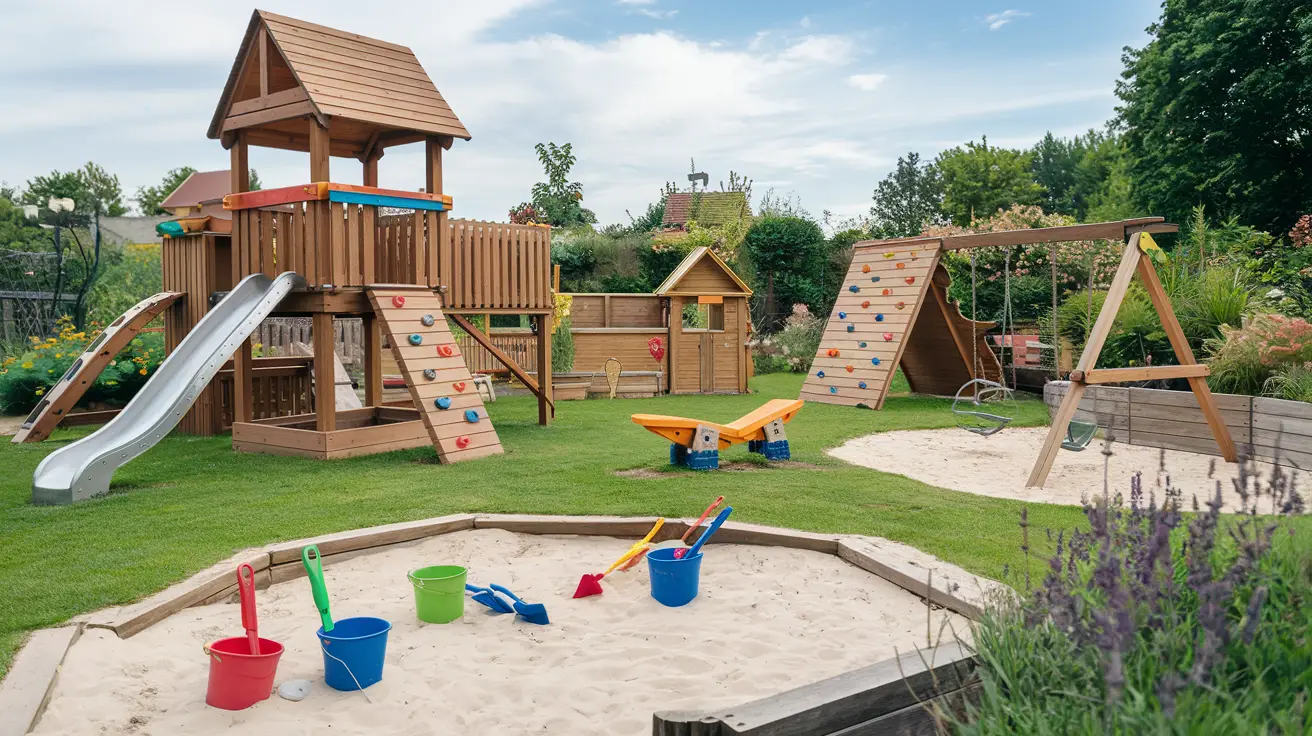
Creating a magical outdoor play space for your children isn’t just about giving them a place to burn off energy—it’s about sparking their imagination, encouraging exploration, and making lifelong memories. A well-designed garden playground can be so much more than a standard swing set on a patch of grass. With a little creativity, you can transform your backyard into an enchanting wonderland where your kids can climb, dig, build, and discover.
Think back to your own childhood. Chances are, your best outdoor adventures weren’t in a perfectly manicured yard but in places filled with hidden corners, makeshift forts, and natural elements that let your imagination run wild. That’s the magic we want to recreate—play spaces that blend seamlessly with nature, inviting kids to explore in a way that feels organic rather than artificial.
The best part? You don’t need a huge budget or professional landscapers to achieve this. Whether you have a small backyard or acres of land, there are countless ways to design a play area that grows with your children. From natural log climbing zones and whimsical fairy-tale gardens to raised vegetable beds that encourage hands-on learning, the options are endless. The key is to mix elements of adventure, creativity, and nature, all while making sure the space remains safe and practical for everyday play.
In this article, we’ll explore a variety of inspiring children’s garden play area ideas—some rustic, some colorful, but all designed to make the outdoors an irresistible place to be. Whether your child loves climbing, digging, or simply daydreaming in their own secret corner, you’ll find ideas here to bring their perfect play space to life.
Ready to create a backyard paradise where your little ones can run free, explore nature, and let their imaginations soar? Let’s dive into these creative play area ideas!
1. Natural Back Garden Play Space with Logs and Wood Chip
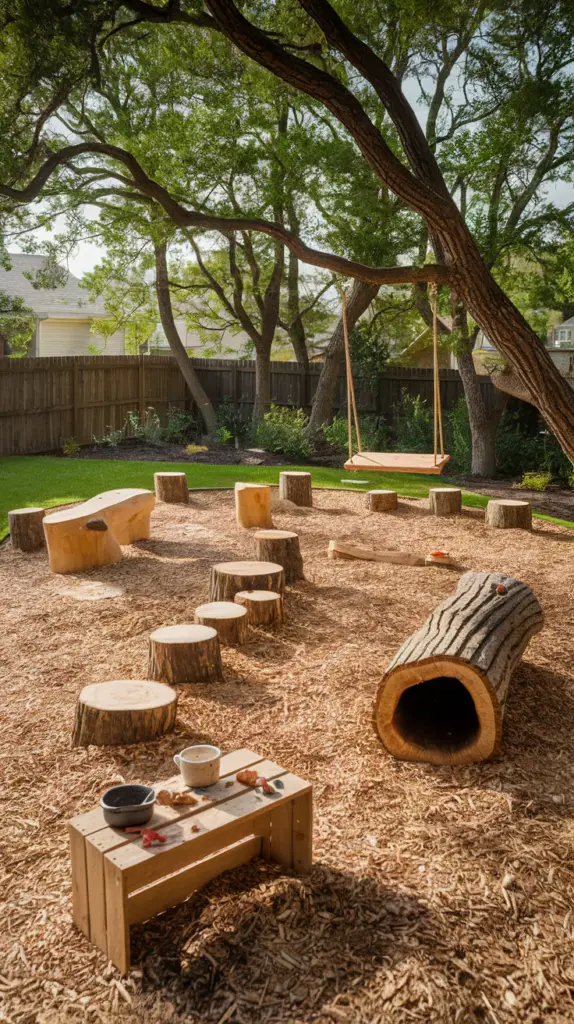
A natural back garden play space is one of the best ways to create an engaging, eco-friendly playground that blends beautifully with its surroundings. By using natural materials like logs, wood chips, and boulders, you can design an area that feels adventurous and organic while being safe and practical for children to enjoy. This kind of play space encourages open-ended play, helping kids develop their balance, coordination, and problem-solving skills as they navigate natural obstacles.
Planning Your Natural Play Space

Start by choosing a dedicated area in your garden that feels tucked away yet remains visible for supervision. Ideally, a shaded spot under a tree works well, as it keeps the play area cool in summer while adding to the natural aesthetic. If you have a sloped area, even better—hills create great opportunities for climbing, sliding, and building small hideaways.
Mark out the play space with a soft border, such as logs, tree stumps, or low wooden fencing. This helps define the area while keeping it visually appealing. A ground covering of wood chips, bark mulch, or sand is ideal for safety, providing a soft landing while keeping the space low-maintenance.
Key Features to Include
• Log Balancing Beams – Arrange sturdy logs of varying heights to create a balance challenge. These can be placed horizontally on the ground for beginners or slightly raised for older children.
• Climbing Stumps – Position different-sized tree stumps to encourage jumping, climbing, and stepping from one to another.
• A Small Mud Kitchen – An upcycled wooden bench or a few crates can be transformed into a fun mud kitchen, where kids can “cook” with leaves, twigs, and soil.
• Hollow Logs and Tunnels – Large logs with hollow centers create fun tunnels for crawling through or playing hide-and-seek.
• Dens and Tipis – Provide a mix of branches, sticks, or even a simple wooden frame covered with fabric to allow kids to build their own natural dens.
Adding Accessories and Extra Play Elements
While the foundation of a natural play space is built from logs and wood chips, small accessories can enhance the experience. Consider adding:
• A rope swing tied securely to a sturdy tree branch.
• Outdoor chalkboards attached to fences or trees for creative expression.
• Buckets and baskets for collecting leaves, stones, and nature treasures.
• A digging pit with small spades and tools for sensory play.
Maintaining Your Natural Play Space
A natural play area requires occasional upkeep to keep it safe and engaging. Check logs and stumps regularly for signs of rot or loose bark that may cause splinters. Refresh the wood chip flooring when needed to maintain a soft landing surface. If you have plants or shrubs around the play area, choose non-toxic varieties and trim any overgrown branches that could obstruct play.
A natural back garden play space offers endless possibilities for fun and creativity. It’s a simple, budget-friendly way to encourage children to engage with nature while providing them with a safe and exciting place to play. By incorporating logs, wood chips, and thoughtful play elements, you can transform an ordinary backyard into an inspiring outdoor retreat where kids can explore, climb, and imagine to their heart’s content.
2. Whimsical Garden Playground with a Wooden Climbing Frame and Small Fairy-Tale Decorations
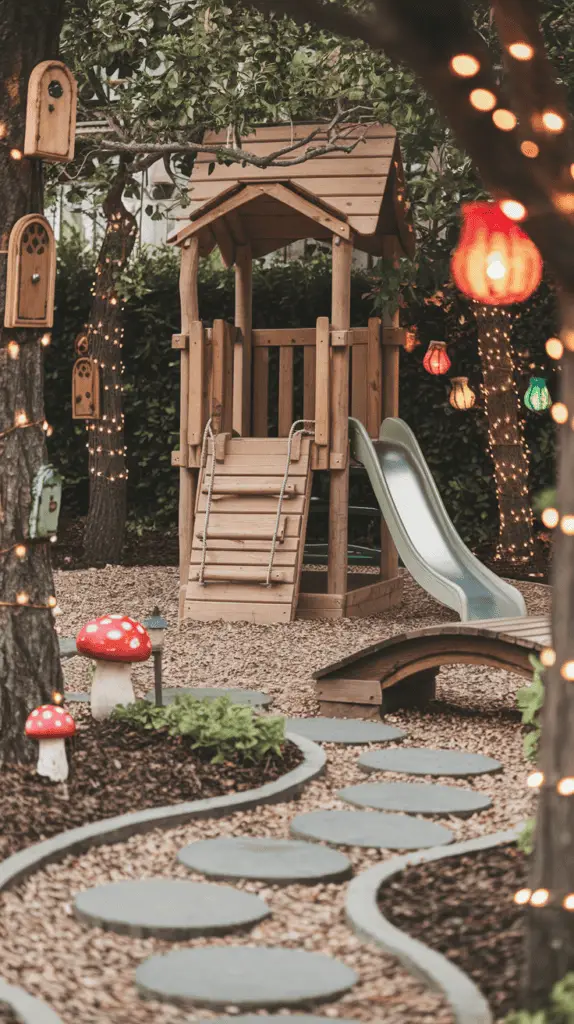
If you want to create a garden play space that feels straight out of a storybook, a whimsical playground with a wooden climbing frame and fairy-tale decorations is the perfect choice. This type of play area brings a sense of magic and adventure to your backyard, turning it into a space where kids can become explorers, castle defenders, or woodland fairies.
Planning a Whimsical Play Space
Start by choosing a central feature—this will likely be the wooden climbing frame. A rustic, natural wood frame blends beautifully with the garden and can include fun additions like a rope ladder, a small slide, or a lookout tower. If you have space, positioning it near a tree or shrubbery helps create a more immersive, enchanted feel.
Then, think about how you want to frame the play area. A mix of soft, grassy surfaces and natural materials like bark mulch or wood chips makes a great base. Adding curved pathways leading to the play zone can create a sense of wonder, as if children are discovering a hidden secret in the garden.
Fairy-Tale Decorations to Bring It to Life
It’s the little details that turn an ordinary backyard into a whimsical wonderland. Here are some fun ideas to create that storybook charm:
• Mini Fairy Doors & Windows – Attach small wooden doors to trees or the base of the climbing frame. It’s a simple but magical touch that makes kids wonder if tiny creatures live there!
• Hanging Lanterns or String Lights – Soft lighting adds a dreamy feel, especially in the early evening when the garden glows. Solar-powered fairy lights wrapped around tree branches or wooden posts work beautifully.
• Painted Stepping Stones – Create a colorful pathway leading to the play area using hand-painted stepping stones in bright, playful designs.
• A Small Wooden Bridge – Even if there’s no water, a little bridge made from wooden planks adds a fairy-tale element and serves as a fun play feature.
• Wind Chimes and Hanging Ornaments – The gentle sounds of wind chimes make the space feel even more magical. You can also hang colorful ribbons, dream catchers, or upcycled decorations from tree branches.
Making It Fun and Functional
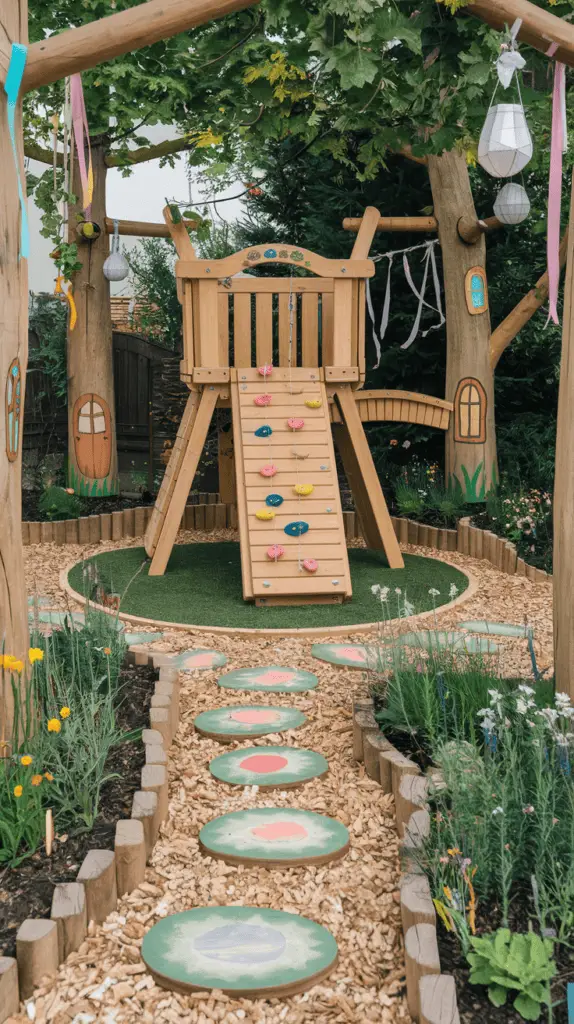
While aesthetics matter, the play area also needs to be engaging. Think about how your child plays—do they love climbing and sliding? Are they more into make-believe games? Tailor the space to their interests.
• Add a Secret Hideaway – Consider tucking a small wooden playhouse or a covered den under part of the climbing frame. Kids love having their own little world within a play space.
• Incorporate a Nature Play Area – A tiny garden bed nearby where kids can plant flowers or herbs makes the space feel even more immersive.
• Use a Mix of Textures – Soft grassy areas, wooden surfaces, and stone paths create a more engaging sensory experience.
Your Own Whimsical Touch
Have you ever built a fort in your backyard as a kid? What made it feel magical? Maybe it was the little details—like a secret entrance only you knew about, or the way sunlight filtered through the trees at just the right angle. Try to bring some of that same childlike wonder into your garden play space.
With a well-placed wooden climbing frame, fairy-tale accents, and thoughtful design elements, you can create a backyard playground that feels like an enchanted escape. The best part? Your kids will have a space where their imaginations can run wild, whether they’re pirates on a wooden ship, knights in a castle, or woodland explorers discovering something new every day.
3. Raised Garden Beds for Kids to Grow Their Own Vegetables and a Small Climbing Frame Built into the Hillside
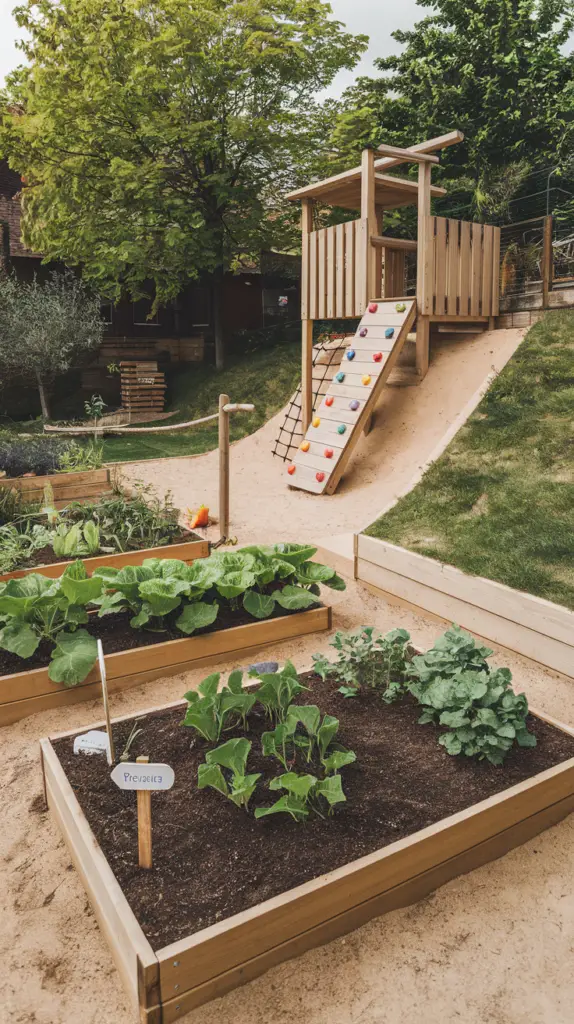
Imagine a garden play area where kids can not only run, climb, and explore but also get their hands dirty growing their own vegetables. This setup blends outdoor adventure with hands-on learning, making it a fantastic way to encourage children to interact with nature in a fun and meaningful way. By combining raised vegetable beds with a small wooden climbing frame built into a gentle slope, you create a space where kids can nurture plants, climb, dig, and play—all in one engaging outdoor environment.
Designing the Space
The first step is to divide the play area into two distinct but connected sections. One area should feature raised garden beds where children can grow their own veggies, herbs, or flowers. The other section will have a small climbing frame, ideally built into a gentle hillside or raised mound to create a multi-level play experience.
If your garden is naturally flat, you can create a small slope using a mix of soil and wooden retaining edges. This slight elevation adds dimension to the space and makes the climbing frame feel more adventurous. Positioning the vegetable garden and play area close together allows kids to move freely between them, making it easy for them to engage with both at the same time.
Building the Raised Garden Beds
Raised beds are perfect for a kids’ garden because they define the growing space, making it easier to manage and more inviting. Here’s how to make them kid-friendly:
• Keep the Beds Low and Accessible – A height of about 30–40cm is ideal for little ones to reach into comfortably.
• Use Safe, Natural Materials – Wooden borders made from untreated timber work best. Avoid chemically treated wood, as kids will be touching the soil often.
• Create Different Planting Zones – Dedicate sections of the bed for different types of plants, like quick-growing vegetables (carrots, radishes), colorful flowers (marigolds, sunflowers), and sensory plants (lavender, mint).
• Add a Simple Watering Station – A small watering can, a rainwater collection barrel, or even a little bucket system makes watering easy and fun.
Incorporating a Hillside Climbing Frame
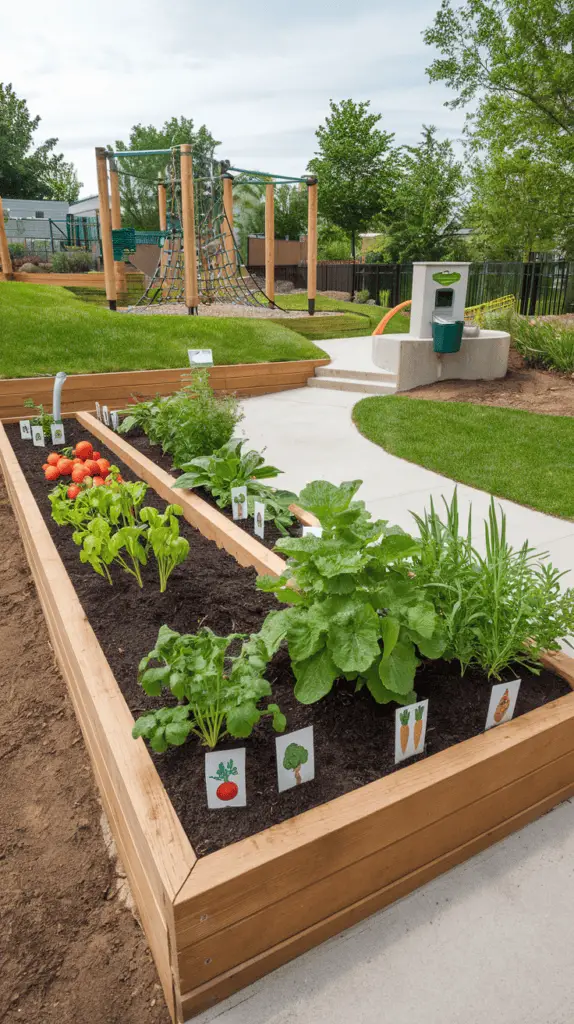
The climbing frame should feel like a natural extension of the landscape rather than a separate structure. Since it’s built into the hillside or raised mound, kids get a different experience compared to a standard playset. Some fun elements to include:
• A Short Wooden Ladder or Rope Climb – Leading up the side of the slope, giving kids an exciting way to reach the top.
• A Small Slide Down – A simple plastic or wooden slide integrated into the hill makes coming down just as fun as climbing up.
• Tunnel or Hideaway Beneath – If the hill allows, adding a small tunnel or shaded play nook underneath the climbing frame gives kids a secret space to explore.
• Balance Beams or Log Stepping Stones Nearby – These can be positioned to connect the climbing area to the garden beds, encouraging movement and exploration between both spaces.
Encouraging Kids to Get Involved
One of the best things about this type of garden play space is that it teaches kids about nature in a hands-on way. They’ll see firsthand how plants grow, learn responsibility by taking care of their little garden, and get excited about eating vegetables they grew themselves.
You can make it even more engaging by:
• Letting them choose what to plant – Kids love ownership, and picking their own seeds makes them more invested.
• Creating fun garden signs – Use painted rocks or small wooden signs with hand-drawn labels to mark different plants.
• Introducing garden-themed play – A “garden shop” where kids pretend to sell their vegetables or a “bug hotel” where they can observe insects adds even more fun.
Bringing the Space to Life
Have you ever tried growing something as a kid? There’s something magical about checking on your plants every day, waiting for that first sprout to appear. A space like this invites kids to experience that joy, while also offering them a place to run, climb, and explore. It’s a perfect blend of activity and learning, designed to grow with them over the years.
With a mix of raised beds, natural wooden elements, and a thoughtfully placed climbing frame, this play area becomes more than just a playground—it’s a little outdoor world where kids can grow, discover, and play at their own pace.
4. DIY Wooden Playground with a Rustic Charm, Surrounded by Trees
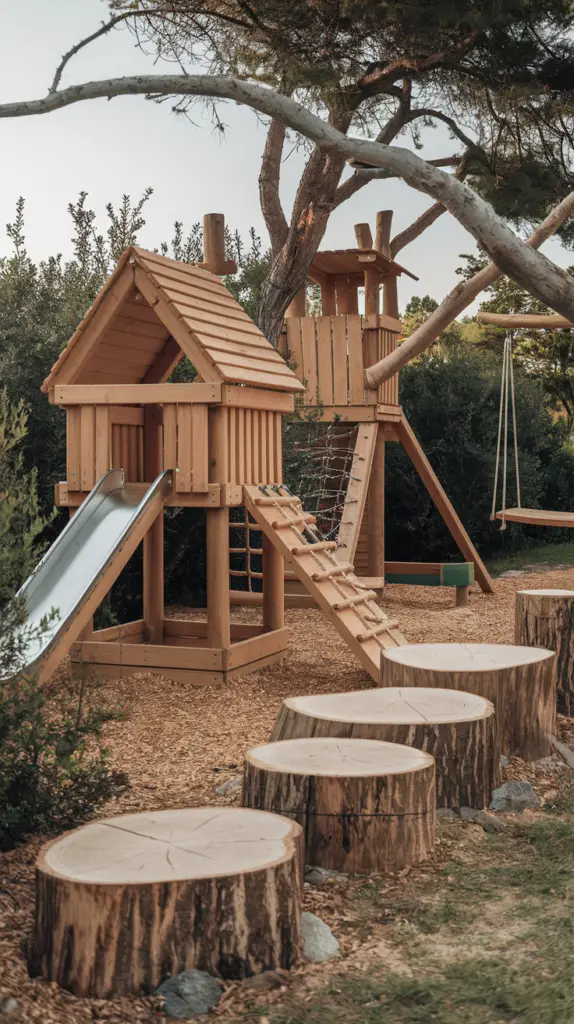
There’s something timeless about a wooden playground, especially one that blends naturally into its surroundings. If your garden has trees, why not use them to create a rustic play space that feels like an adventure hideout? Unlike brightly colored plastic playsets, a DIY wooden playground has a warm, organic feel that fits beautifully into any backyard. Plus, building it yourself (or at least customizing it) gives you the freedom to create something unique for your kids—whether that’s a treehouse, a climbing structure, or a mix of both.
Planning Your Rustic Wooden Playground
Think about what kind of play your kids enjoy most. Do they love climbing? Swinging? Building secret forts? A rustic wooden playground should encourage all these things while keeping a natural, back-to-basics feel. Positioning the play structure near trees makes it feel more immersive, like a hidden woodland escape. If you don’t have trees, you can still create a rustic feel by using reclaimed wood, rough-hewn logs, and earthy materials like rope and stone.
Key Features to Include
• A Wooden Climbing Frame – This could be as simple as a basic wooden A-frame with a rope ladder, or as elaborate as a multi-level fort with different access points.
• Tree Stump Steps or Balance Beams – If you have old logs lying around, cut them into different heights and place them in a row for jumping and balancing fun.
• A Simple Rope Swing – If you have a sturdy tree, a basic rope swing or a wooden disc swing is an easy addition.
• A Wooden Playhouse or Lookout Tower – A small elevated fort with a ladder and a lookout window makes a great “secret hideout.”
• Bridges and Walkways – If you have space, connecting different play areas with small wooden bridges or rope walkways adds an extra adventure element.
The Fun of DIY
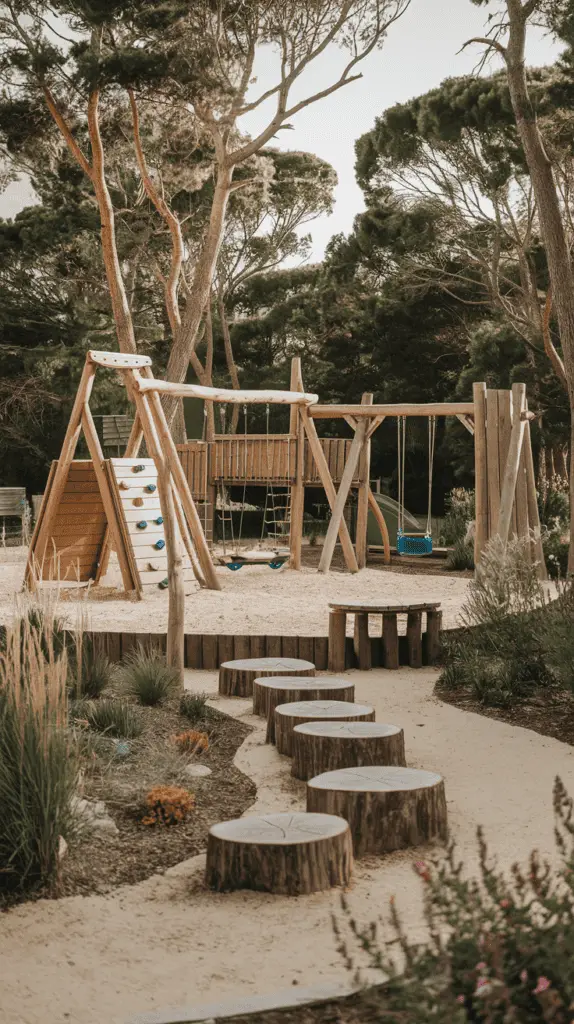
Building a wooden playground yourself (or with a little help) can be an incredibly rewarding project. Even if you’re not an expert builder, you can start small and add on over time. Have you ever built something in your backyard as a kid? Maybe a treehouse, a simple wooden fort, or even just a pile of planks you turned into a hideout? There’s something special about making your own space, and giving your kids that same experience makes it even more meaningful.
If you’re short on time, you can also modify a basic wooden playset by adding rustic details—use reclaimed wood, rough-cut logs, or even hand-painted signs to make it feel more natural.
Blending the Playground with the Garden
One of the best parts of a rustic wooden playground is that it blends in with the landscape instead of looking artificial. Planting wildflowers around the edges, placing logs or large stones as natural seating, and using bark mulch or wood chips as a base all help to create a more natural look.
A well-placed wooden playground, tucked among trees and built with care, can become more than just a play area—it can be a place where childhood memories are made, where little adventurers climb, hide, and let their imaginations run free.
5. Family Garden design with Colourful Wooden Borders to Define Play Zones
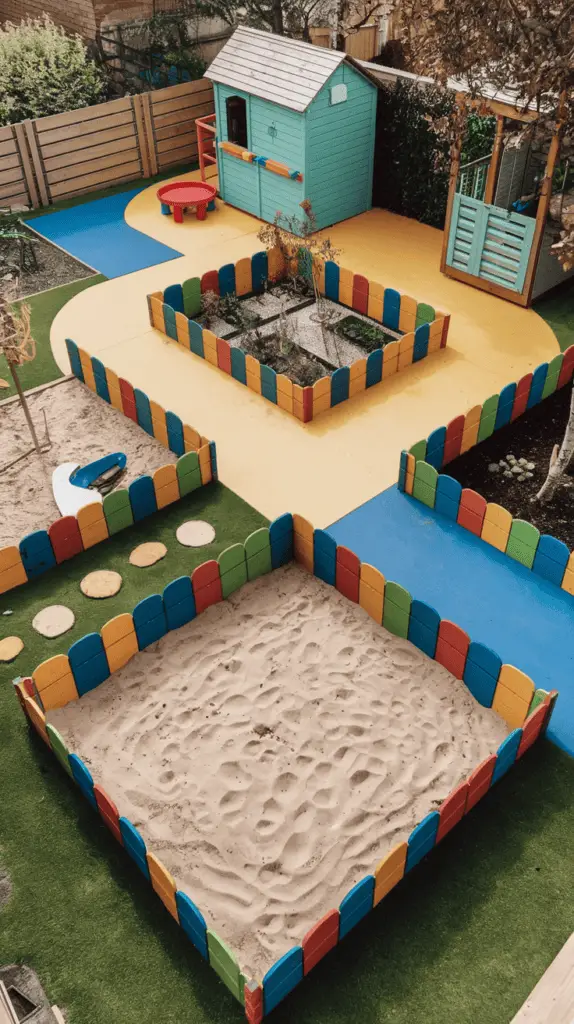
Sometimes, it’s the small details that bring a garden play space together. If you want to add a fun, structured feel to your backyard playground without taking away from the natural elements, colourful wooden borders are a great way to define different play areas while adding a cheerful touch.
This idea works particularly well if you have multiple play zones—maybe a sandpit in one area, a small climbing frame in another, and a mini garden space for the kids to dig and explore. Brightly painted wooden borders help separate these areas, making the garden feel organized and exciting at the same time.
Choosing the Right Borders
Wooden borders can be as simple or as creative as you want. Some easy ideas include:
• Short, Colourful Wooden Planks – Painted in bright colors and arranged in a picket-fence style. This works great for enclosing sandpits, garden beds, or sensory play areas.
• Log Edging – If you prefer a more rustic feel, cut logs into short sections and use them to create a natural border. You can even paint the tops in different colors to add a playful twist.
• Reclaimed Pallet Wood – Upcycling old pallets is a budget-friendly way to create durable, colorful edging for play zones.
• Curved Wooden Borders – Instead of straight lines, using curved or wavy wooden edging creates a more organic, whimsical look.
Making It Fun for Kids
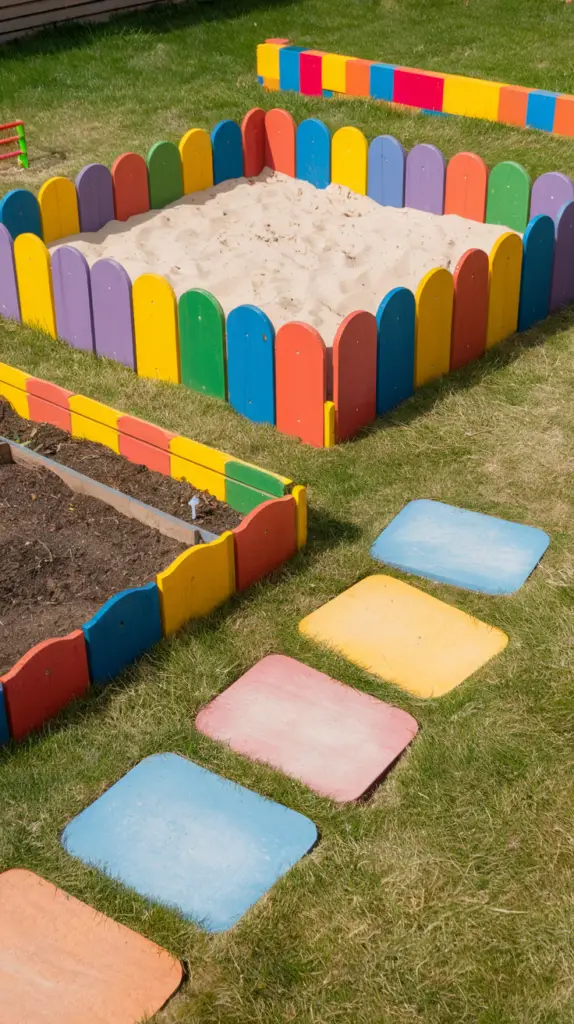
One way to get children excited about their play area is to let them be part of the process. Have you ever let kids loose with a paintbrush? It’s messy, fun, and always results in something unique! Let them help paint the wooden borders in their favorite colors or even decorate them with handprints, patterns, or little drawings.
If you want to tie in a theme, you can even paint the borders to match the rest of the play area—soft pastels for a fairy-tale theme, bright primary colors for a classic playground look, or earthy tones for a natural, rustic feel.
Defining Different Play Spaces
Colourful wooden borders work well in so many areas of a children’s garden playground, including:
• Sandpits – A wooden border helps keep the sand contained while adding a pop of color.
• Mud Kitchens – Edging around a mud play area helps keep things a little more organized (though let’s be honest, it will still get delightfully messy!).
• Mini Garden Patches – Kids love having their own space to dig and plant. A bordered-off section of the garden lets them know this is their special area.
• Balance or Stepping Stones – If you have a pathway leading between play areas, colorful borders can make it more inviting and fun.
Keeping It Low-Maintenance
Wooden borders are relatively easy to maintain, but a little effort goes a long way. If you’re using painted wood, consider sealing it with a weather-resistant finish to keep the colors vibrant for longer. For a more natural look, untreated wooden logs will gradually age and blend beautifully into the surroundings.
The Power of a Pop of Colour
A few splashes of color can completely transform the look of a play area. Have you ever walked into a space that just felt instantly happy? That’s the power of bright, playful design! Colourful wooden borders not only help define play zones but also make the whole garden feel more welcoming and child-friendly.
With just a little effort, you can turn an ordinary backyard into a vibrant, organized, and playful space where kids feel excited to explore every day.
6. Multi-Level Grass Areas with Wooden Climbing Frames
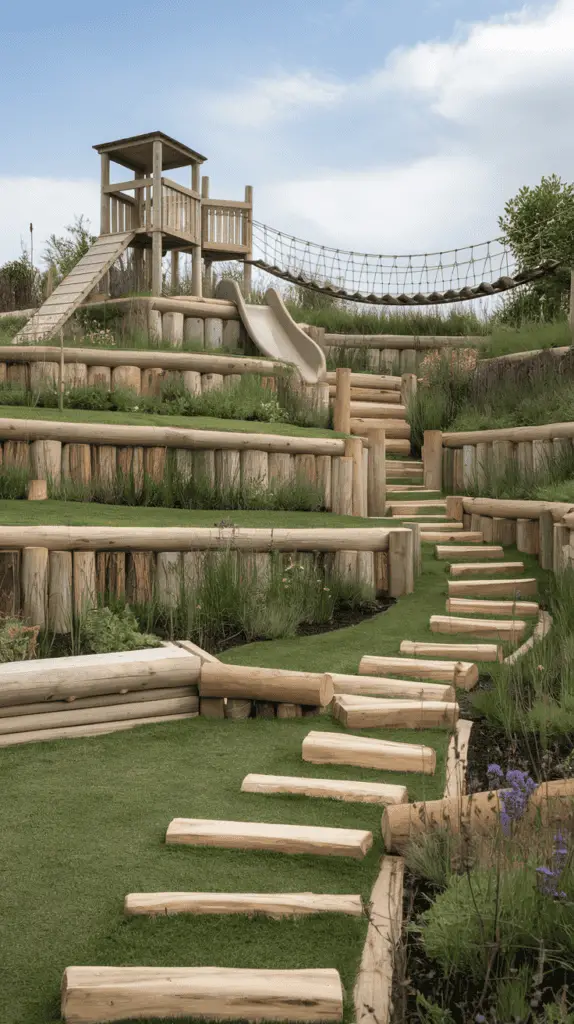
Have you ever noticed how kids are naturally drawn to changes in terrain? A simple grassy hill, a slope, or even just a raised area can become the perfect setting for adventure. A multi-level grass area with wooden climbing frames adds excitement and movement to a garden playground, encouraging kids to jump, climb, roll, and explore in a way that feels completely natural. Instead of a flat, predictable play space, this design creates an ever-changing landscape for play.
Why Multi-Level Play Works So Well
Think back to when you were a kid—did you ever run up a hill just to roll back down? Or use a small mound as a castle, fort, or secret hideout? Elevation changes naturally spark creativity. A multi-level grassy area makes climbing and exploring more interesting while adding a soft, natural play surface. It also gives you opportunities to integrate different play elements in a way that flows together rather than feeling like separate structures.
Designing a Multi-Level Play Area
The first step is to work with what you already have. If your garden has existing slopes or uneven ground, you’re in luck—you can enhance those natural features rather than leveling them out. If your space is flat, you can still create gentle mounds using soil and turf to form rolling play hills. These don’t have to be huge—even a slight variation in height makes a difference.
Once you’ve mapped out the levels, think about where to position climbing frames, tunnels, or platforms. Connecting different heights with wooden structures makes movement between levels more fun.
Ideas for Multi-Level Play Features
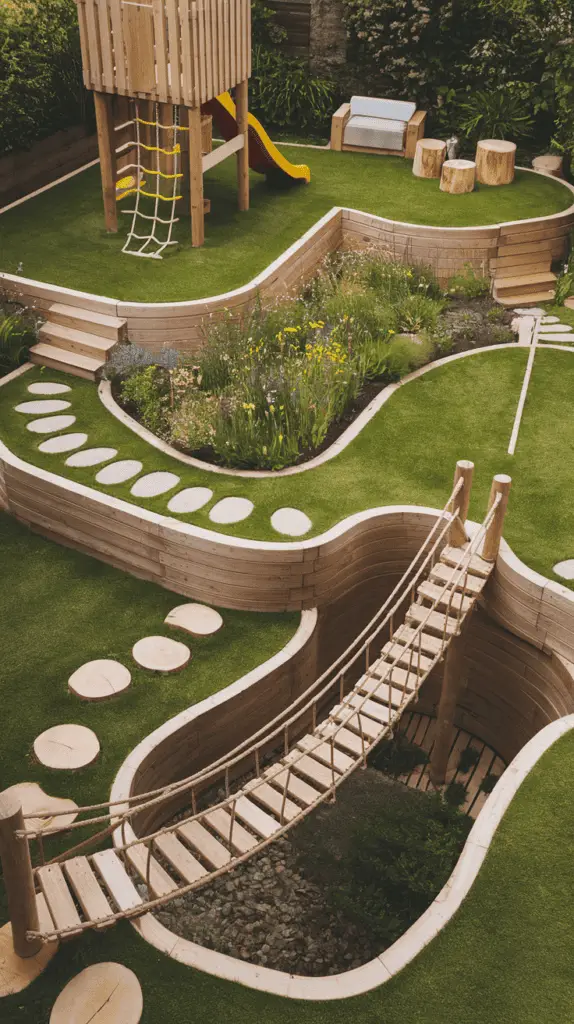
• Wooden Climbing Ramps or Scramble Nets – A low wooden ramp with climbing holds or a net to scramble up is a great way to move between levels.
• Built-in Hillside Slides – Instead of a free-standing slide, integrate one directly into the slope for a seamless, natural look.
• Stepping Logs or Boulder Paths – Placing logs or large stones between grassy levels adds a fun balancing challenge.
• Hidden Tunnels and Passages – If you have a larger hill, you can carve out a crawl-through tunnel for an extra sense of adventure.
• Lookout Platforms or Small Wooden Towers – Raised wooden platforms can serve as pirate ships, castles, or secret hideouts, offering a whole new perspective of the garden.
Keeping It Play-Friendly
To keep a multi-level grass play area fun and safe, focus on:
• Soft, Durable Grass or Ground Cover – If your kids will be running, tumbling, and climbing, opt for hard-wearing grass varieties or consider mixing in some artificial turf for high-traffic areas.
• Secure Wooden Structures – Climbing frames should be anchored properly and built with smooth, sanded wood to prevent splinters.
• Gradual Slopes for Safety – While a little height variation is great for play, avoid steep drops or sharp edges. If necessary, use wooden beams or low retaining walls to define the edges.
Making It Feel Like an Adventure
A multi-level playground naturally invites open-ended play. One day it’s a mountain to conquer, the next it’s a jungle hideout. You can encourage even more creativity by adding small details:
• A rope bridge between levels for that Indiana Jones-style thrill.
• A mini digging or excavation zone where kids can “discover” buried treasures.
• A flower or vegetable patch on one level so kids can interact with plants as part of their play.
Bringing Nature Into Play
A space like this isn’t just about climbing frames—it’s about making the whole garden part of the adventure. If you’re lucky enough to have trees, use them! A low-hanging branch can become a natural monkey bar, or a shady spot under a tree can turn into a cozy reading or picnic nook.
Even small elevation changes make a big difference in how a play space feels. Whether it’s rolling down a hill, running up a ramp, or hiding behind a raised platform, a multi-level play area turns a regular backyard into an adventure zone kids will want to explore every day.
7. Sensory Play Areas with Sand, Water, and Nature Elements
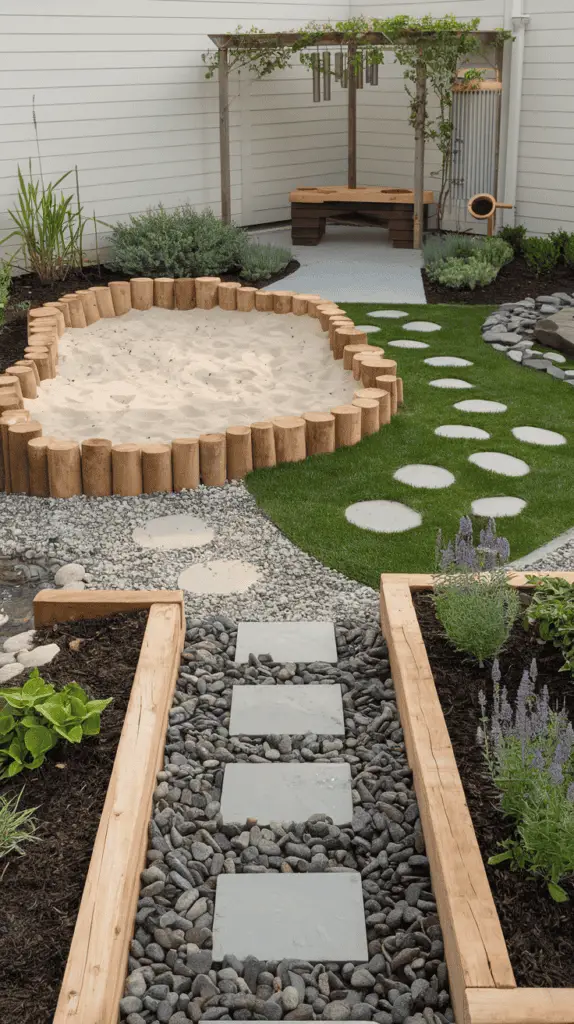
Have you ever noticed how kids love to dig in the dirt, splash in puddles, or run their hands over different textures? That’s because sensory play is a huge part of their development—it helps with motor skills, creativity, and even relaxation. A dedicated sensory play area in your garden gives children a space to explore different textures, sounds, and natural elements in a way that feels both fun and educational.
I once tried setting up a small sand and water play area in a backyard without much planning—big mistake! The sand quickly spread everywhere, and the water feature overflowed onto nearby plants, creating a muddy mess. It taught me an important lesson: sensory play is fantastic, but it needs careful placement and drainage to keep it functional and low-maintenance.
Designing a Sensory Play Area That Works
The key to a great sensory play space is variety. You want to mix materials and textures so that kids can experience different sensations while playing. Consider dedicating a small section of your garden to a mix of sand, water, pebbles, and even plants that engage the senses.
A good layout might include:
• A sandpit or digging area – Perfect for digging, scooping, and building.
• A small water play station – This could be anything from a water table to a DIY trickling stream.
• Natural elements like pebbles, bark, and logs – Great for barefoot exploration.
• Sensory plants – Lavender for scent, lamb’s ear for touch, or even herbs like mint for a burst of fresh aroma.
Choosing the Right Sand and Water Features
Sand and water play is always a favorite, but it can quickly turn into chaos without the right setup. Here’s what I learned from experience:
• Sand needs containment – A raised wooden border keeps it from spilling all over the garden. Covering it when not in use prevents it from becoming a cat’s favorite spot!
• Water should have drainage – If you’re adding a water table or play stream, make sure excess water has a place to drain—otherwise, you’ll end up with a swampy mess.
• Consider a DIY water wall – Using old plastic bottles, pipes, or wooden channels to create a water maze is fun, engaging, and keeps water play more controlled.
Fun Additions to Keep Kids Engaged
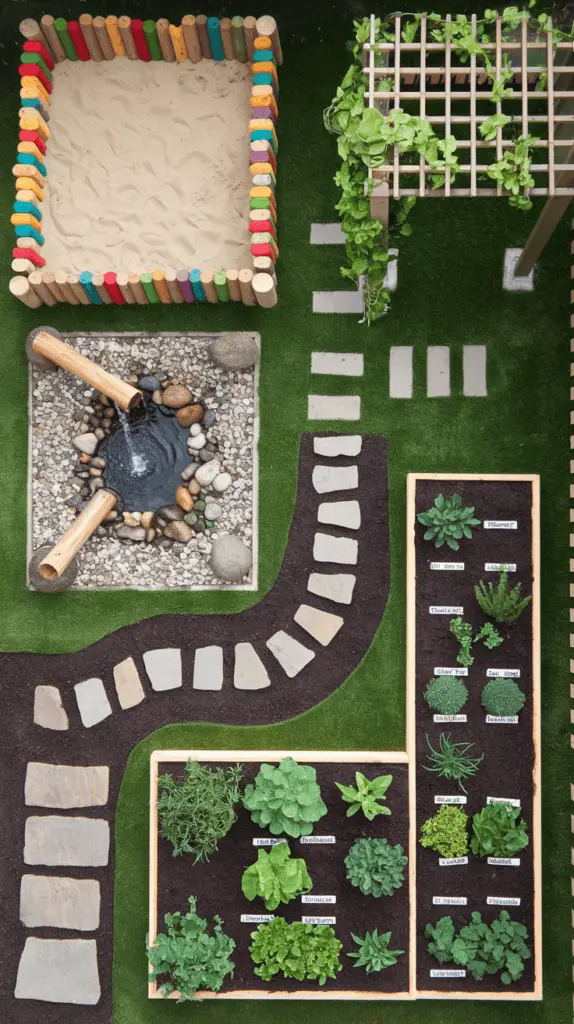
To keep the sensory play area interesting, try adding:
• Loose materials – Buckets, scoops, and small shovels let kids manipulate sand and water freely.
• Textured stepping stones – Arrange a pathway with different materials (smooth stones, bark, grass) for a fun barefoot walk.
• A small mud kitchen – Kids love mixing “potions” out of dirt, water, and leaves. An old table or some wooden crates work perfectly for this.
Things to Watch Out For
• Mud can take over – If you’re including water, expect things to get messy! Position the area away from main walking paths to avoid tracking dirt everywhere.
• Beware of mosquitoes – Stagnant water attracts bugs. If you’re using a water feature, make sure it drains properly or circulates to prevent mosquito breeding.
• Supervision is still key – Even shallow water can be a hazard for younger kids, so always keep an eye on them during water play.
A Space for All Ages
One of the best things about a sensory garden is that it’s not just for little kids. Older kids can enjoy the textures and water features just as much, and adults might find the sensory plants soothing, too!
With a bit of planning, a sensory play area becomes a space where kids can explore, create, and interact with nature in a way that’s both fun and calming.
8. Backyard Adventure Zone with Tunnels and Hiding Spots
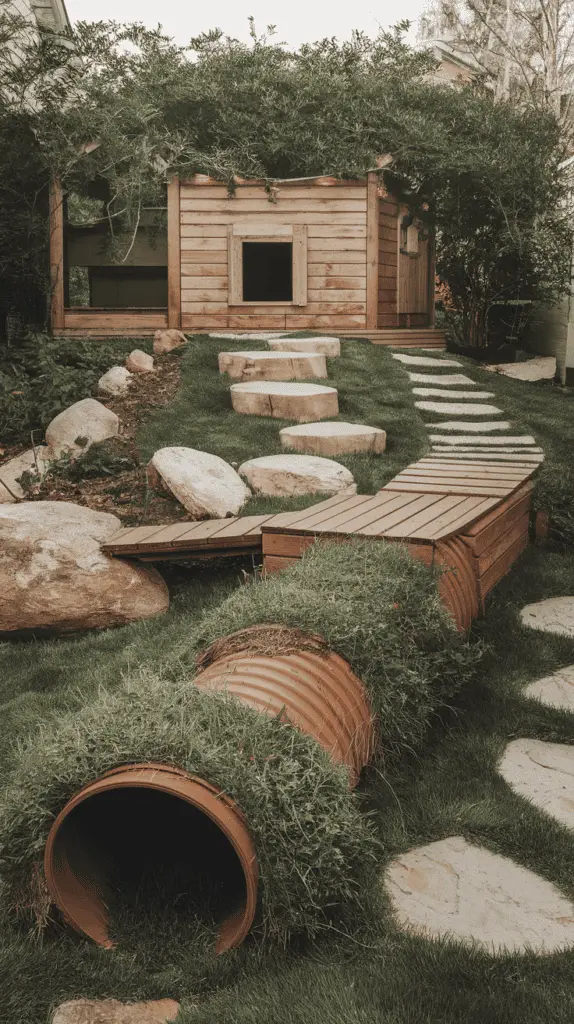
There’s something about tunnels, hidden spaces, and secret pathways that instantly captivate kids. A backyard adventure zone filled with tunnels and hiding spots creates a play area that sparks curiosity, encourages movement, and turns the garden into a space full of discovery. Whether your child loves playing hide-and-seek, crawling through tunnels, or creating their own little fort, this type of play area offers endless fun.
I once helped set up an adventure-style play space in a backyard, and one of the biggest challenges was getting the tunnels right. The first time, we used lightweight plastic tunnels, but they kept collapsing or shifting when kids ran through them. Eventually, we switched to semi-buried wooden tunnels and sturdy pipe tunnels covered with plants, which worked much better.
Designing an Adventure Play Space
The key to a great adventure zone is making it feel like an exploration area. Instead of just one feature, try layering different elements that work together:
• A crawling tunnel – This could be a large plastic pipe, a wooden tunnel, or even a simple arched pathway covered with climbing plants.
• Bushy hideaways – Planting thick shrubs or tall grasses can create natural hideouts where kids can escape and play pretend.
• A wooden fort with hidden entrances – Adding an opening underneath or a back “secret exit” makes even a simple playhouse more exciting.
• Rocky stepping paths or mini mazes – Using stones or wooden planks to form a winding trail adds a sense of adventure.
Making the Tunnels Work
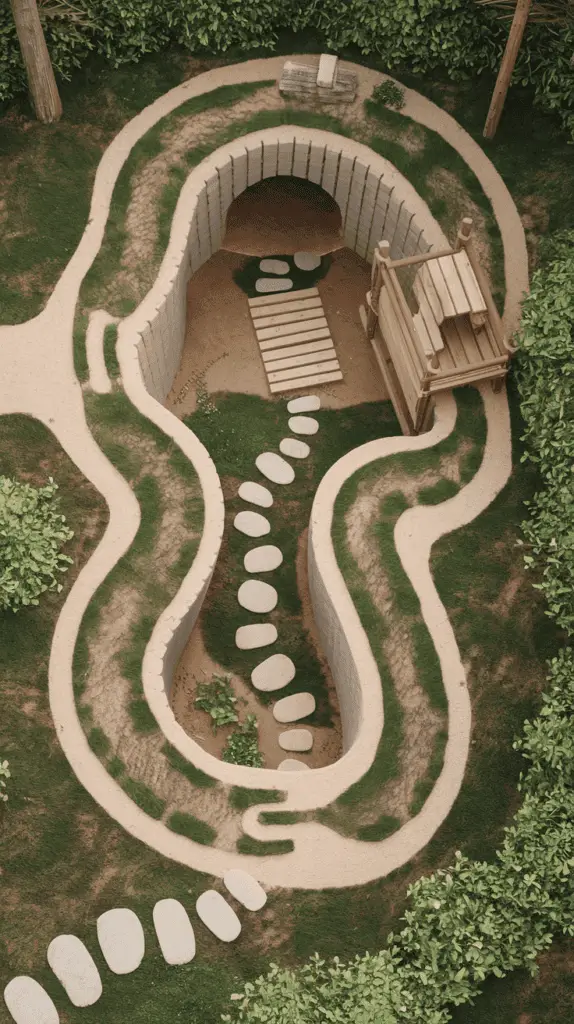
If you’re adding tunnels, think about:
• Stability – Tunnels need to be sturdy enough for kids to crawl through without collapsing. Buried tunnels or wooden-framed tunnels tend to hold up better than lightweight ones.
• Breathability – Avoid enclosed tunnels that get too hot in the summer. Leave openings at both ends for airflow.
• Blending with the garden – Cover tunnels with grass, flowers, or climbing plants to make them feel like part of the landscape.
Fun Extras to Keep It Exciting
• A hidden “spy hole” in a tunnel wall for peeking out.
• Secret messages – Painted rocks or little wooden signs hidden around the space for kids to find.
• A climbing element – A rope net, low rock wall, or wooden ladder leading up to a lookout point.
A well-planned adventure play space isn’t just about running around—it’s about sparking imagination. One day, the tunnels might be a secret escape route from a castle, the next they’re an underground animal den. With the right mix of tunnels, hiding spots, and creative elements, you can create a backyard world full of endless possibilities.
9. Upcycled Materials for a Sustainable Kids’ Playground

Not every amazing play space needs brand-new materials. In fact, some of the most creative and engaging garden playgrounds are made from upcycled materials. Repurposing old wood, tires, pallets, or even household items can save money, reduce waste
, and add a unique, rustic charm to your garden play area. Plus, there’s something extra satisfying about building a playground that has its own story behind it.
I once tried making a tire climbing structure, thinking it would be a quick and easy project. It turns out that securing the tires properly was trickier than expected—they kept shifting until we bolted them down with rebar. Lesson learned: upcycled projects are great, but they need the same planning and safety checks as store-bought play equipment!
Finding the Right Upcycled Materials
Here are some great materials you can repurpose for a kids’ playground:
• Old tires – Perfect for climbing structures, swings, or even balancing paths when half-buried in the ground.
• Wooden pallets – Can be transformed into everything from forts and bridges to balance beams and seating.
• Tree stumps – Great for natural stepping stones, log balance beams, or rustic table and chairs.
• Rope and fabric scraps – Useful for DIY hammocks, swings, or even a shade canopy.
• PVC pipes – Can be repurposed into water play stations, tunnels, or even musical instruments.
Easy Upcycled Playground Ideas
• Tire Climbing Pyramid – Stack and bolt together old tires to create a fun climbing structure.
• Pallet Playhouse or Fort – Secure wooden pallets together to form walls, add a roof, and let kids decorate it.
• Balance Beam from Old Logs – A simple but effective play feature that encourages coordination.
• Hanging Bottle Chimes – Recycle plastic or glass bottles into a musical play area.
• DIY Water Play Station – Use old pipes and containers to create a fun water flow system.
Things to Watch Out For
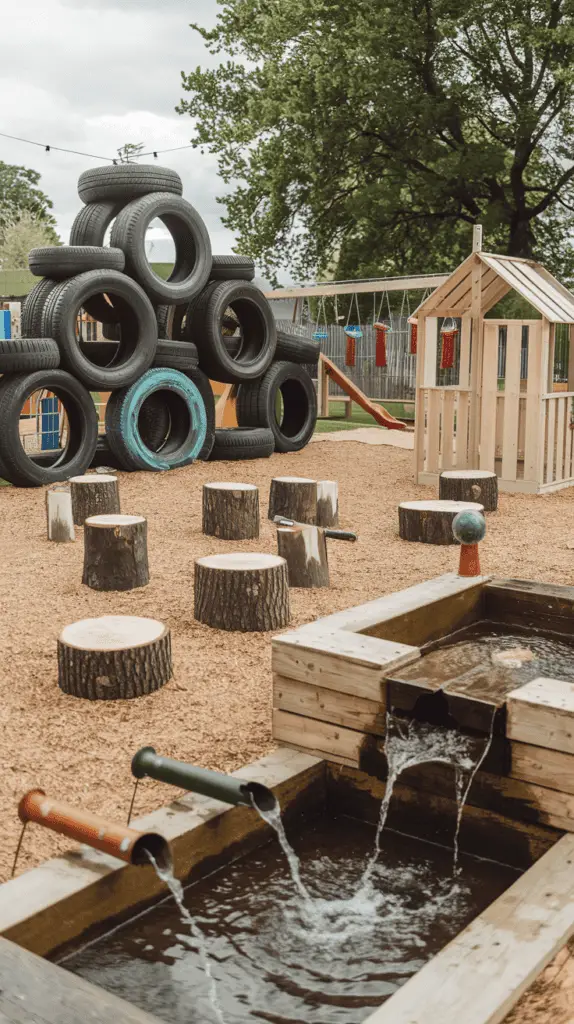
Upcycled playgrounds are fantastic, but safety always comes first:
• Check for sharp edges, nails, or splinters – Sand down wood and secure any loose pieces.
• Make sure materials are weather-resistant – Some items, like untreated wood, may rot if left outside.
• Secure everything properly – Even upcycled structures need to be stable and anchored to avoid tipping over.
Adding Personality to the Space
One of the best things about upcycled playgrounds is that they’re totally unique. Have your kids help paint the structures, pick out decorations, or even come up with their own play ideas. Upcycling isn’t just about saving materials—it’s about making something one-of-a-kind that sparks creativity and adventure.
With a little creativity, repurposed materials can become the foundation of an amazing backyard playground. Not only does it save money, but it also teaches kids the value of reusing and creating something new from old. If you’ve ever tackled a DIY upcycling project, you know the satisfaction of seeing it come to life—so why not turn that energy into an unforgettable play space?
10. Interactive Garden Spaces with Learning and Play Combined
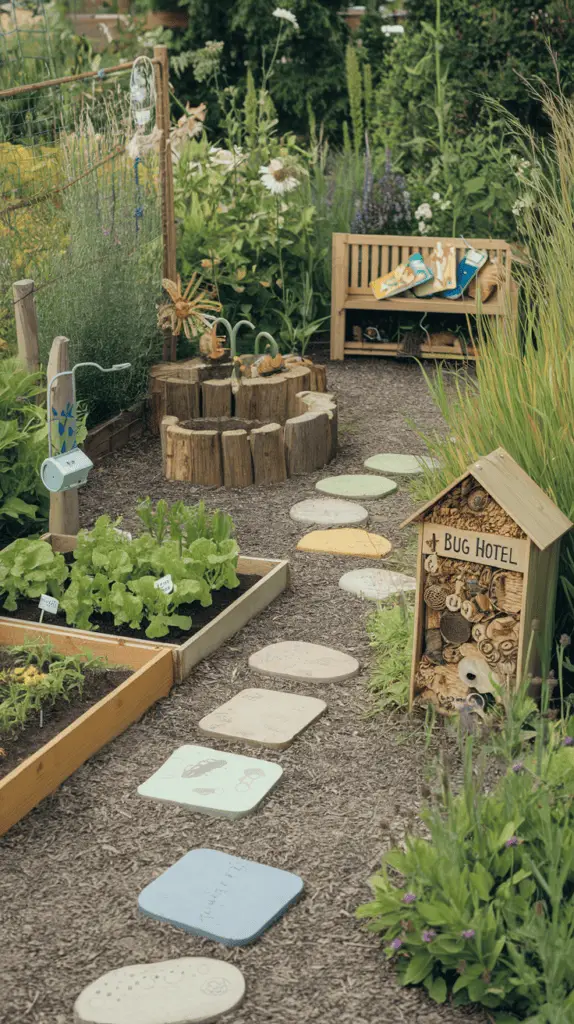
A great children’s garden isn’t just about running, jumping, and climbing—it can also be a space for creativity, learning, and hands-on discovery. Interactive garden spaces blend play with education, turning the backyard into an outdoor classroom where kids can engage with nature, develop new skills, and fuel their curiosity. Whether it’s through growing their own food, experimenting with sound and movement, or engaging in DIY science activities, an interactive garden adds depth to playtime.
I once helped set up a small interactive garden for kids, thinking they’d be most excited about growing plants. But to my surprise, the real hit was a simple outdoor xylophone made from metal tubes—they loved experimenting with sounds! It made me realize that interactive play isn’t just about learning facts; it’s about discovering through experience.
Elements to Include in an Interactive Garden
The best interactive gardens offer a mix of hands-on activities, problem-solving elements, and open-ended play opportunities. Consider including:
• A Grow-Your-Own Vegetable Patch – Kids get to plant, water, and eventually harvest their own food. Raised beds or small container gardens work well for this.
• A Simple Outdoor Music Area – Hanging pots, metal pipes, or wooden chimes can create a fun musical experience.
• A DIY Weather Station – A rain gauge, wind chimes, and a homemade sundial let kids track the weather and learn about nature.
• Puzzle Paths and Hidden Messages – Stepping stones with numbers, letters, or symbols make a playful learning trail.
• An Insect Observation Zone – A “bug hotel” made from logs and hollow sticks encourages kids to observe nature up close.
Encouraging Learning Through Play
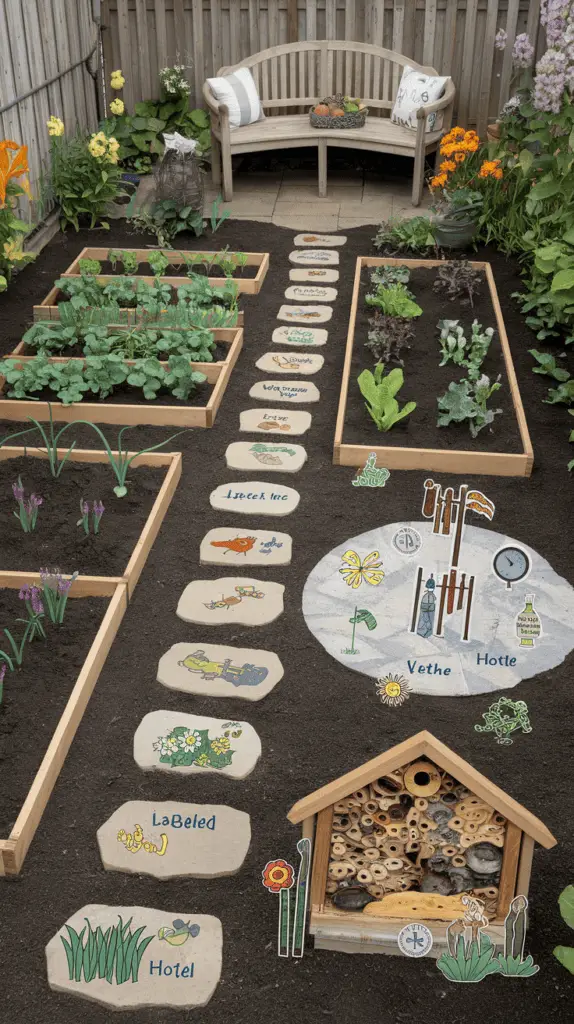
One of the best ways to make an interactive garden engaging is by framing activities as little experiments.
• “What happens if we plant these seeds in the shade vs. the sun?” – Helps kids learn about plant growth.
• “Can you hear different sounds when you tap different materials?” – Encourages exploration through sound play.
• “Let’s follow the shadows at different times of day!” – Teaches about the sun’s movement.
By turning play into discovery, kids naturally develop an interest in the world around them.
What to Watch Out For
• Keep it age-appropriate – While older kids may love detailed experiments, younger kids benefit more from simple, sensory-based interactions.
• Choose durable materials – Outdoor musical instruments, stepping stones, and learning features should withstand weather and frequent use.
• Let the space evolve – The best interactive gardens grow with the children. Start with simple elements and add more complex activities over time.
An interactive garden space brings learning to life in a way that no indoor classroom ever could. Whether they’re growing plants, making music, or solving puzzles, kids get to experience the joy of discovery firsthand. The best part? They won’t even realize they’re learning—they’ll just be having fun.
Final Thoughts: Bringing Your Children’s Garden Play Area to Life
Designing a fun and engaging garden play area for children is more than just adding a swing set—it’s about creating a space that encourages creativity, exploration, and adventure. Whether you’re drawn to natural play spaces, whimsical fairy-tale settings, or interactive learning gardens, the possibilities are endless.
The best outdoor play areas grow with your children, evolving as they develop new interests and skills. From rustic wooden playgrounds surrounded by trees to colorful wooden borders that define different play zones, each idea in this article offers a unique way to make your backyard an irresistible place for kids to explore.
A well-designed play space isn’t just about the equipment—it’s about the memories made. Think back to your own childhood. What were the outdoor spaces that sparked your imagination? Maybe it was a simple climbing tree, a hidden hideout, or a patch of dirt where you built castles. The beauty of a thoughtfully planned children’s garden is that it can provide that same sense of magic and adventure for your little ones.
And remember, you don’t need a huge budget or a perfectly landscaped yard to make it happen. Sometimes, the most exciting play features come from upcycled materials, DIY projects, and natural elements already in your garden. A pile of logs can become a balance course, a tunnel can spark endless hide-and-seek games, and a small vegetable garden can teach kids about nature in the most hands-on way.
So, whether you’re creating a backyard filled with adventure zones, quiet reading nooks, or hands-on learning spaces, the most important thing is that it’s a place where kids can be kids—running, climbing, imagining, and growing.
What will you create in your backyard? Let your imagination (and your child’s) lead the way!
